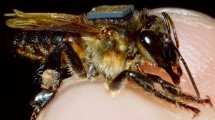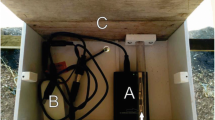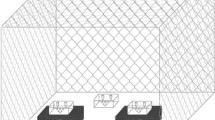Abstract
Losses of foraging bees are sometimes attributed to altered flight pattern between a meliferous plant treated with an insecticide and the hive. Only a limited number of studies has investigated the impact of pesticides on homing flight due to the difficulty of measuring the flight time between the food source and the hive. Monitoring the flights of the foraging bees needs their individual identification. The number of bees monitored simultaneously and the time span during which observations can be made limit most of the monitoring techniques. However, techniques of automatic tracking and identification of individuals have the potential to revolutionize the study of the ecotoxicological effects of xenobiotics on the bee behaviors. Radio Frequency Identification (RFID) offer numerous advantages such as an unlimited number of codes, a large number of simultaneous recording, and a quick reading, especially through materials (e.g., wood). The aim of this study was to show how the RFID device can be used to study the effects of pesticides on both the behavioral traits and the lifespan of bees. In this context, we have developed a method under tunnel to automatically record the displacements of foragers individualized with RFID tags and to detect the alteration of the flight pattern between an artificial feeder and the hive. Fipronil was selected as test substance due to the lack of information on the effects of this insecticide on the foraging behavior of free-flying bees. We showed that oral treatment of 0.3 ng of fipronil per bee (LD50/20) reduced the number of foraging trips. The strengths of our approach were briefly discussed.





Similar content being viewed by others
References
CST (Comité Scientifique et Technique de l’Etude Multifactorielle des Troubles des Abeilles) (2004) Imidaclopride utilisé en enrobage de semences (Gaucho®) et troubles des abeilles. Final report
Aliouane Y, Kacimi El Hassani A, Gary V, Armengaud C, Lambin M, Gauthier M (2009) Subchronic exposure of honeybees to sublethal doses of pesticides: effect on behavior. Environ Toxicol Chem 28:113–122
Bortolotti L, Montanari R, Marcelino J, Medrzycki P, Maini S, Porrini C (2003) Effects of sub-lethal imidacloprid doses on the homing rate and foraging activity of honey bees. Bull Insectol 56:63–67
Chauzat MP, Carpentier P, Martel AC, Bougeard S, Cougoule N, Porta P, Lachaize J, Madec F, Aubert M, Faucon JP (2009) Influence of pesticide residues on honeybee Hymenoptera Apidae colony health in France. Environ Entomol 38:514–523
Cole LM, Nicholso RA, Casida JE (1993) Action of phenylpyrazole insecticides at the GABA gated chloride channel. Pestic Biochem Phys 46:47–54
Colin ME, Bonmatin JM, Moineau I, Gaimon C, Brun S, Vermandere JP (2004) A method to quantify and analyze the foraging activity of honey bees: relevance to the sublethal effects induced by systemic insecticides. Arch Environ Con Tox 47:387–395
Cox DR (1972) Regression models and life tables. Biometrics 38:67–77
Cox RL, Wilson WT (1984) Effects of permethrin on the behavior of individually tagged honey bees, Apis mellifera L. (Hymenoptera: Apidae). Environ Entomol 13:375–378
Dechaume-Moncharmont FX, Decourtye A, Hennequet C, Pham-Delègue MH, Pons O (2003) Statistical analysis of the Honeybee survival after chronic exposure to insecticides. Environ Toxicol Chem 22(12):3088–3094
Decourtye A, Devillers J (2010) Ecotoxicology of neonicotinoids insecticides in the bees. In: Thany S (ed) Insect nicotinic acetylcholine receptors. Landes Bioscience, St. Austin, TX
Decourtye A, Lacassie E, Pham-Delègue MH (2003) Learning performances of honeybees (Apis mellifera L) are differentially affected by imidacloprid according to the season. Pest Manage Sci 59:269–278
Decourtye A, Devillers J, Genecque E, Le Menach K, Budzinski H, Cluzeau S, Pham-Delègue MH (2005) Comparative sublethal toxicity of nine pesticides on olfactory learning performances of the honeybee Apis mellifera. Arch Environ Con Tox 48:242–250
Decourtye A, Lefort S, Devillers J, Gauthier M, Aupinel P, Tisseur M (2009) Sublethal effects of fipronil on the ability of honeybees (Apis mellifera L.) to orientate in a complex maze. Julius-Kühn-Archiv 423:75–83
Desneux N, Decourtye A, Delpuech JM (2007) The sublethal effects of pesticides on beneficial arthropods. Annu Rev Entomol 52:81–106
EPPO (European, Mediterranean Plant Protection Organization) (1992) Guideline on test methods for evaluating the side effects of plant protection products on honeybees. OEPP/EPPO Bull 22:203–215
Gronenberg W (1987) Anatomical and physiological properties of feedback neurons of the mushroom bodies in the bee brain. Exp Biol 46:115–125
Higes M, Martin R, Meana A (2006) Nosema ceranae, a new microsporidian parasite in honeybees in Europe. J Invertebr Pathol 92(2):93–95
Hodges D (1952) The pollen load of the honeybee. London Bee Research Association, London
Ikeda T, Zhao X, Kono Y, Yeh JZ, Narahashi T (2003) Fipronil modulation of glutamate-induced chloride currents in cockroach thoracic ganglion neurons. NeuroToxicology 24:807–815
Kacimi El Hassani A, Dacher M, Gauthier M, Armengaud C (2005) Effects of sublethal doses of fipronil on the behavior of the honeybee (Apis mellifera). Pharmacol Biochemist Behav 82:30–39
Kacimi El Hassani A, Giurfa M, Gauthier M, Armengaud C (2008) Inhibitory neurotransmission and olfactory memory in the honeybee. Neurobiol Learn Mem 90:589–595
Kacimi El Hassani A, Dupuis J, Gauthier M, Armengaud C (2009) Glutamatergic and gabaergic effects of fipronil on olfactory learning and memory in the honeybee. Invert Neurosci 9(2):91–100
Leal SM, Neckameyer WS (2002) Pharmacological evidence for GABAergic regulation of specific behaviors in Drosophila melanogaster. J Neurobiol 50:245–261
Maleszka R, Helliwell P, Kucharski R (2000) Pharmacological interference with glutamate re-uptake impairs long-term memory in the honeybee, Apis mellifera. Behav Brain Res 115:49–53
Maxim L, van der Sluijs JP (2007) Uncertainty: cause or effect of stakeholders’ debates? Analysis of a case study: the risk for honeybees of the insecticide Gaucho. Sci Total Environ 376:1–17
Medrzycki P, Montanari R, Bortolotti L, Sabatini AG, Maini S (2003) Effects of imidacloprid administered in sub-lethal doses on honey bee behaviour. Laboratory tests. Bull Insectol 56:59–62
Oldroyd BP (2007) What’s killing American honey bees? PLOS Biol 5:1195–1199
R Development Core Team (2009) R: a language and environment for statistical computing. R Foundation for Statistical Computing, Vienna
Ribbands CR (1953) The behaviour and social life of honeybees. London Bee Research Association, London
Riley JR, Smith AD (2002) Design considerations for an harmonic radar to investigate the flight of insects at low altitude. Comput Electron Agric 35:151–169
Rortais A, Arnold G, Halm MP, Touffet-Briens F (2005) Modes of honeybees exposure to systemic insecticides: estimated amounts of contaminated pollen and nectar consumed by different categories of bees. Apidologie 36:71–83
Rybak J, Menzel R (1993) Anatomy of the mushroom bodies in the honey bee brain: the neuronal connections of the alpha-lobe. J Comp Neurol 334:444–465
Schricker B, Stephen WP (1970) The effects of sublethal doses of parathion on honeybee behaviour. I. Oral administration and the communication dance. J Apicult Res 9:141–153
Streit S, Bock F, Pirk CWW, Tautz J (2003) Automatic life-long monitoring of individual insect behaviour now possible. Zoology 106:169–171
Suchail S, Guez D, Belzunces LP (2001) Discrepancy between acute and chronic toxicity induced by imidacloprid and its metabolites in Apis mellifera. Environ Toxicol Chem 20:2482–2486
Thompson HM, Maus C (2007) The relevance of sublethal effects in honey bee testing for pesticide risk assessment. Pest Manag Sci 63:1058–1061
Usherwood PN, Grundfest H (1965) Peripheral inhibition in skeletal muscle of insects. J Neurophysiol 28:497–518
van Engelsdorp D, Hayes J, Underwood RM, Pettis J (2008) A survey of honey bee colony losses in the U.S., Fall 2007 to Spring 2008. PLoS ONE 3(12):1–6
Vandame R, Meled M, Colin ME, Belzunces LP (1995) Alteration of the homing-flight in the honey bee Apis mellifera L. exposed to sublethal dose of Deltamethrin. Environ Toxicol Chem 14:855–860
Waddell S, Quinn WG (2001) Flies, genes and learning. Annu Rev Neurosci 24:1283–1309
Yang EC, Chuang YC, Chen YL, Chang LH (2008) Abnormal foraging behavior induced by sublethal dosage of imidacloprid in the honey bee (Hymenoptera: Apidae). J Econ Entomol 101(6):1743–1748
Acknowledgments
This work was supported by grants from the European Community program (1221/97) for French beekeeping coordinated by French Ministry of Agriculture.
Author information
Authors and Affiliations
Corresponding author
Rights and permissions
About this article
Cite this article
Decourtye, A., Devillers, J., Aupinel, P. et al. Honeybee tracking with microchips: a new methodology to measure the effects of pesticides. Ecotoxicology 20, 429–437 (2011). https://doi.org/10.1007/s10646-011-0594-4
Accepted:
Published:
Issue Date:
DOI: https://doi.org/10.1007/s10646-011-0594-4




